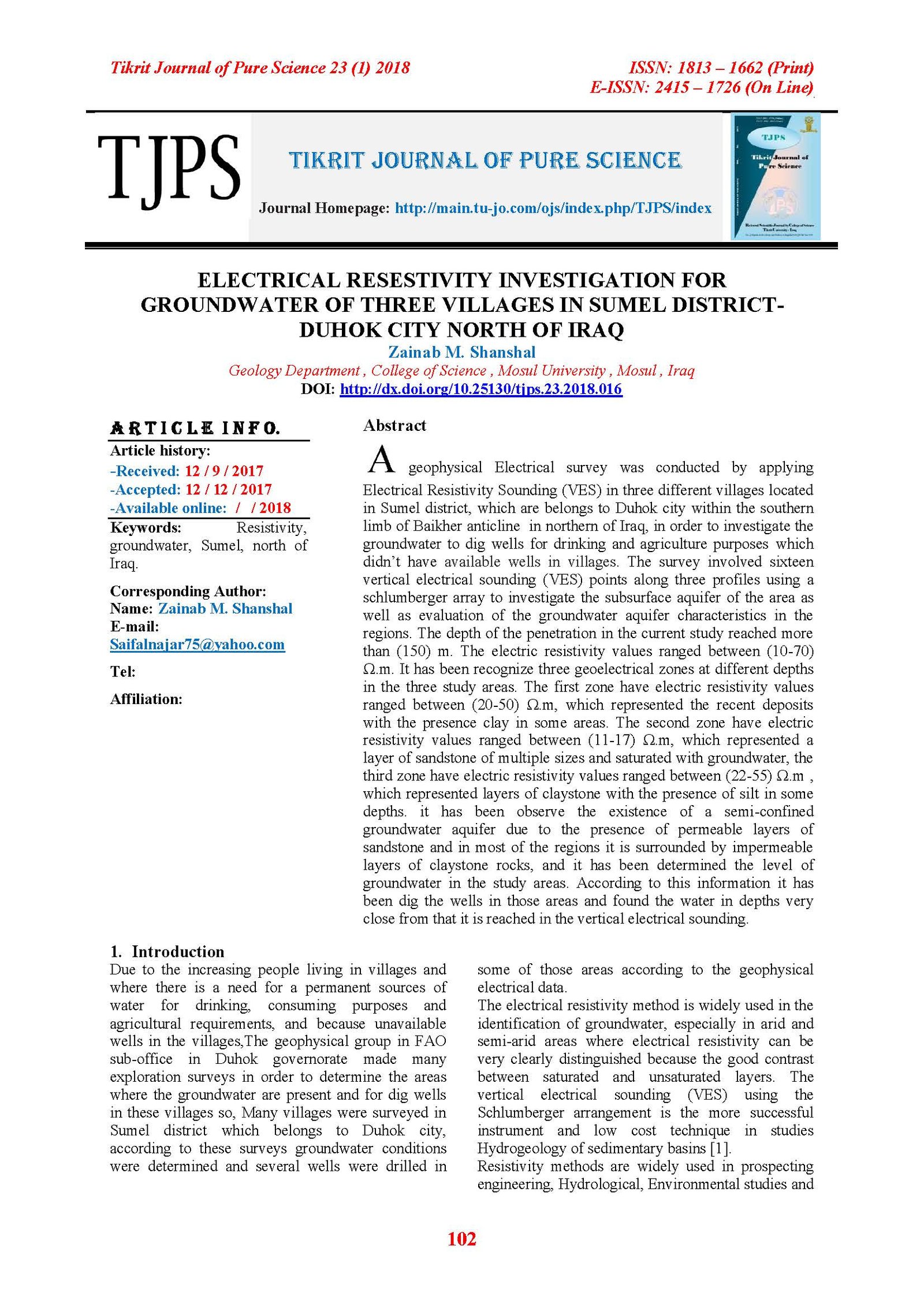ELECTRICAL RESESTIVITY INVESTIGATION FOR GROUNDWATER OF THREE VILLAGES IN SUMEL DISTRICT-DUHOK CITY NORTH OF IRAQ
Main Article Content
Abstract
A geophysical Electrical survey was conducted by applying Electrical Resistivity Sounding (VES) in three different villages located in Sumel district, which are belongs to Duhok city within the southern limb of Baikher anticline in northern of Iraq, in order to investigate the groundwater to dig wells for drinking and agriculture purposes which didn’t have available wells in villages. The survey involved sixteen vertical electrical sounding (VES) points along three profiles using a schlumberger array to investigate the subsurface aquifer of the area as well as evaluation of the groundwater aquifer characteristics in the regions. The depth of the penetration in the current study reached more than (150) m. The electric resistivity values ranged between (10-70) Ω.m. It has been recognize three geoelectrical zones at different depths in the three study areas. The first zone have electric resistivity values ranged between (20-50) Ω.m, which represented the recent deposits with the presence clay in some areas. The second zone have electric resistivity values ranged between (11-17) Ω.m, which represented a layer of sandstone of multiple sizes and saturated with groundwater, the third zone have electric resistivity values ranged between (22-55) Ω.m , which represented layers of claystone with the presence of silt in some depths. it has been observe the existence of a semi-confined groundwater aquifer due to the presence of permeable layers of sandstone and in most of the regions it is surrounded by impermeable layers of claystone rocks, and it has been determined the level of groundwater in the study areas. According to this information it has been dig the wells in those areas and found the water in depths very close from that it is reached in the vertical electrical sounding.
Article Details

This work is licensed under a Creative Commons Attribution 4.0 International License.
Tikrit Journal of Pure Science is licensed under the Creative Commons Attribution 4.0 International License, which allows users to copy, create extracts, abstracts, and new works from the article, alter and revise the article, and make commercial use of the article (including reuse and/or resale of the article by commercial entities), provided the user gives appropriate credit (with a link to the formal publication through the relevant DOI), provides a link to the license, indicates if changes were made, and the licensor is not represented as endorsing the use made of the work. The authors hold the copyright for their published work on the Tikrit J. Pure Sci. website, while Tikrit J. Pure Sci. is responsible for appreciate citation of their work, which is released under CC-BY-4.0, enabling the unrestricted use, distribution, and reproduction of an article in any medium, provided that the original work is properly cited.
References
[1] Nejad, H.T., M. Mumipour, R. Kaboli and O.A. Najib, 2011. Vertical Electrical Sounding (VES) Resistivity Survey Technique to Explore Groundwater in an Arid Region, Southeast Iran. Journal of Applied Sciences, 11: 3765-3774.
[2] Reynolds J. (1998). An introduction to applied and environmental geophysics. 2nd edition, Gohn Wily and Sons, New York, USA, 796p.
[3] Zhdanov, M.S. and Keller, G.V.,1994; The geoelectrical methods in geophysical exploration, Elsevier Scientific puplishing Company, Amestrdam, 873 p. [4] Ramadhan, H.M. (2015). Spatial Analysis and Risk Assessment Study of the proposed Duhok Airport Project for Selevanii plane sumel district-Dohok city. Civilized dialogue, Number 4761.
[5] Nabeel K. Al-Azzawi.,And Safwan T. Al-Hubiti.,2008. The Fold Style Variations of Baikher Anticline - Northern Iraq, Iraqi Journal of Earth Sciences, Vol. 9, No. 1, pp. 1– 20, 2009.
[6] Jassim SZ, Goff JC (2006) Geology of Iraq. first Edition, Dolin, Prague and Moravian Museum, Brno, Czech Republic, 408 P.
[7] Buday T. (1980) The regional geology of Iraq stratigraphy and paleogeography. Dar Al-Kutub publication House, Mosul -Iraq, 352 p.
[8] Dahlin T, Zhou B (2004) A numerical comparison of 2D resistivity imaging with ten electrode arrays. Geophysical Prospect 52:379–398.
[9] Loke MH (2001) Electrical imaging surveys for environmental and engineering studies. A practical guide to 2-D and 3-D surveys, RES2DINV Manual, IRIS Instruments, www.iris-instruments.com
[10] Loke M. H. (2009). Tutorial: 2-D and 3-D electrical imaging surveys www.geoelectrical.com.
[11] IPI2Win (MT) Instruction Manual (2008) IPI2 Win (MT) v. 2.0 Moscow State university Geological Faculty Dept. of Geophysics.
[12] Koefoed, O., 1979; Geo-sounding principles, 1. Receptivity sounding Measurements, Elsevier Scientific publishing company, Amsterdam, 276 p.
